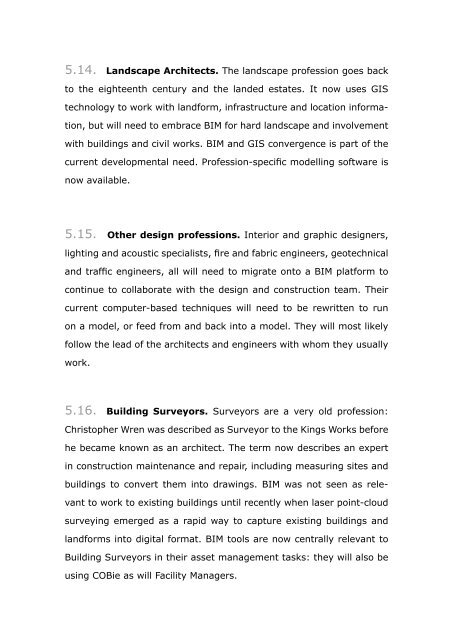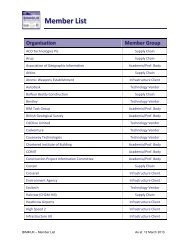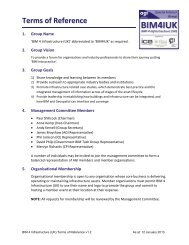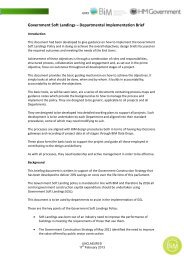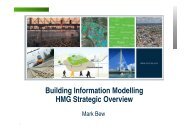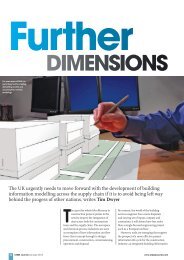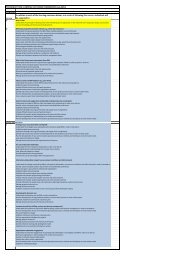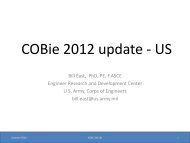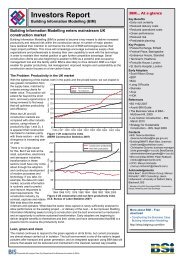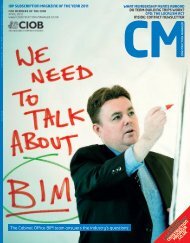Growth through BIM - Institution of Civil Engineers
Growth through BIM - Institution of Civil Engineers
Growth through BIM - Institution of Civil Engineers
- No tags were found...
Create successful ePaper yourself
Turn your PDF publications into a flip-book with our unique Google optimized e-Paper software.
5.14. Landscape Architects. The landscape pr<strong>of</strong>ession goes backto the eighteenth century and the landed estates. It now uses GIStechnology to work with landform, infrastructure and location information,but will need to embrace <strong>BIM</strong> for hard landscape and involvementwith buildings and civil works. <strong>BIM</strong> and GIS convergence is part <strong>of</strong> thecurrent developmental need. Pr<strong>of</strong>ession-specific modelling s<strong>of</strong>tware isnow available.5.17. Town Planners. The planning pr<strong>of</strong>ession is under severalstresses currently, some political and some technical. It emerged out<strong>of</strong> architecture at the start <strong>of</strong> the twentieth century but has become alargely managerial discipline. Development control entails processingthe design <strong>of</strong> proposed development <strong>through</strong> several filters, includingcurrently the sustainability performance <strong>of</strong> the design. Arguably suchsubjects are Building Regulation matters requiring non-planning skills.<strong>BIM</strong> <strong>of</strong>fers support to the planner in enabling designs to be checked5.15. Other design pr<strong>of</strong>essions. Interior and graphic designers,lighting and acoustic specialists, fire and fabric engineers, geotechnicaland traffic engineers, all will need to migrate onto a <strong>BIM</strong> platform tocontinue to collaborate with the design and construction team. Theircurrent computer-based techniques will need to be rewritten to runon a model, or feed from and back into a model. They will most likelyfollow the lead <strong>of</strong> the architects and engineers with whom they usuallywork.automatically against constraints. Singapore has been operating combinedplanning and building regulation processing on an automatedbasis for ten years. The planning rules need to be formatted for thispurpose and UK rules have a performance and discretionary approachrather than a ‘deemed to satisfy’ one. Consideration needs to be givento the potential for a <strong>BIM</strong>-based approach for the UK, as part <strong>of</strong> a review<strong>of</strong> the machinery <strong>of</strong> planning control. <strong>BIM</strong> can also speed up thecreation <strong>of</strong> guidance plans and design codes to allow plan-led control toillustrate acceptable development to applicants as well as to be a basis5.16. Building Surveyors. Surveyors are a very old pr<strong>of</strong>ession:Christopher Wren was described as Surveyor to the Kings Works beforehe became known as an architect. The term now describes an expertin construction maintenance and repair, including measuring sites andbuildings to convert them into drawings. <strong>BIM</strong> was not seen as relevantto work to existing buildings until recently when laser point-cloudfor automated checking. One issue to be explored is the timing <strong>of</strong> planningpermission in the <strong>BIM</strong> Plan <strong>of</strong> Work. As most design work is nowdone by Stage 3, the classic point for planning application, developerswill be loath to commit to such investment before knowing that theycan get permission. Increased use <strong>of</strong> illustrated outline permission atStage 2 would be logical, with details reserved to Stage 3 before anystart on site.surveying emerged as a rapid way to capture existing buildings andlandforms into digital format. <strong>BIM</strong> tools are now centrally relevant toBuilding Surveyors in their asset management tasks: they will also beusing COBie as will Facility Managers.G r o w t h t h r o u g h B I M59


